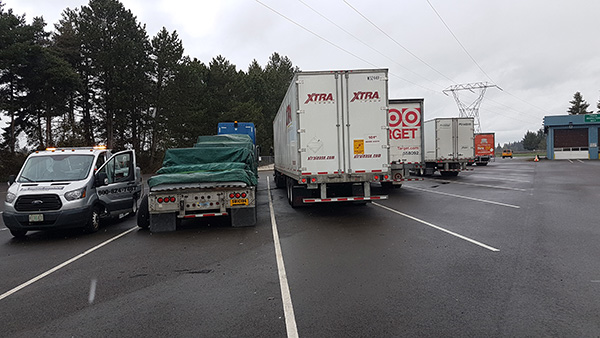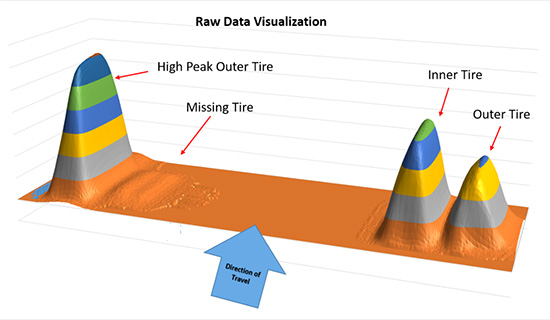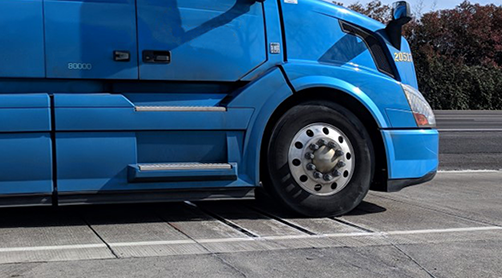At IRD we’ve been developing and integrating advanced sensor technology into intelligent transportation systems for almost 40 years. One of our newest systems, the TACS™ Tire Anomaly and Classification System, is quickly becoming a standard feature of safety screening systems at commercial vehicle inspection facilities.
TACS is an innovative tire safety screening solution that identifies flat, missing, mismatched or underinflated tires using sensor technology that provides 3-D data from tire footprints. There has been a tremendous response from the agencies that have adopted the technology, as they are finding vehicles meeting out-of-service criteria that would otherwise have bypassed inspection. There are now 27 current and committed installations in North America (11 states in the US and 1 province in Canada). Since January 1st of this year, TACS systems have screened over 2.5 million commercial vehicles and detected over 32,000 violations.

Trucks awaiting tire repairs outside a TACS equipped weigh station in Oregon
Some of the features that make TACS such an effective addition to a commercial vehicle inspection program are:
- Flat, Underinflated, Missing and Mismatched Tire Detection – Based on tire footprint measurement, TACS effectively screens for out-of-service (OOS) criteria
- Proven Performance – Numerous state and international references can attest to the effectiveness of TACS
- Proven Accuracy – Nearly 100% of vehicles identified have verified tire anomalies that justify further inspection
- Operator Interface – Options include IRD Operator Display integration, Virtual Weigh Station (VWS) integration, or standalone software – all with detailed output for the user
- Single/Dual/Wide-base Tire Detection – Provides enhanced classification and compliance
- Provides Identification of Specific Location of Tire Anomaly – Graphical User Interface (GUI) indicates axle and tire location on dual (inside or outside)
- Tire Positioning – Off-scale detection for WIM System
- Speed-Independent Screening – Operates at all speed ranges – mainline, ramp, and stop and go
- Web-Based Reporting System – IRD's VI2M™ traffic data central repository and reporting software provides detailed reports on vehicles screened and tire anomalies identified
Illinois is the first state to implement multi-site tire safety screening and more are following suit with statewide screening programs. Over the first eight months of TACS implementation, the Illinois State Police used the technology to detect over 5000 suspect trucks which were sent to report for further inspection.
The success of the Illinois program led to additional sites being added. This project established TACS to be one of the most effective technologies for commercial vehicle safety screening, as the system provides accurate results that are verified by vehicle inspections and lead to placing unsafe vehicles out of service.

Only TACS makes a sort decision based on 3-D tire footprint data
US states that are ITD core compliant are eligible to apply for ITD grants for the addition of TACS to their screening operations. Early adopters of tire safety screening have relied on state funding to purchase TACS, but have now established the effectiveness of the technology as a desirable, even critical, component of advanced commercial vehicle enforcement sites. We expect that states will be successful seeking ITD funding for TACS.
Considering the safety benefits to the public, and the value TACS provides to enforcement operations, we expect many more agencies worldwide to adopt the technology.



